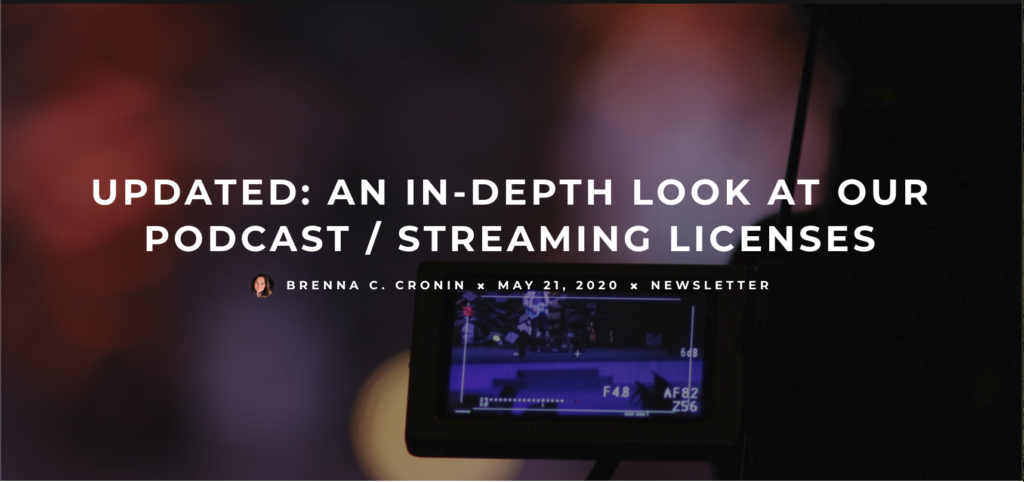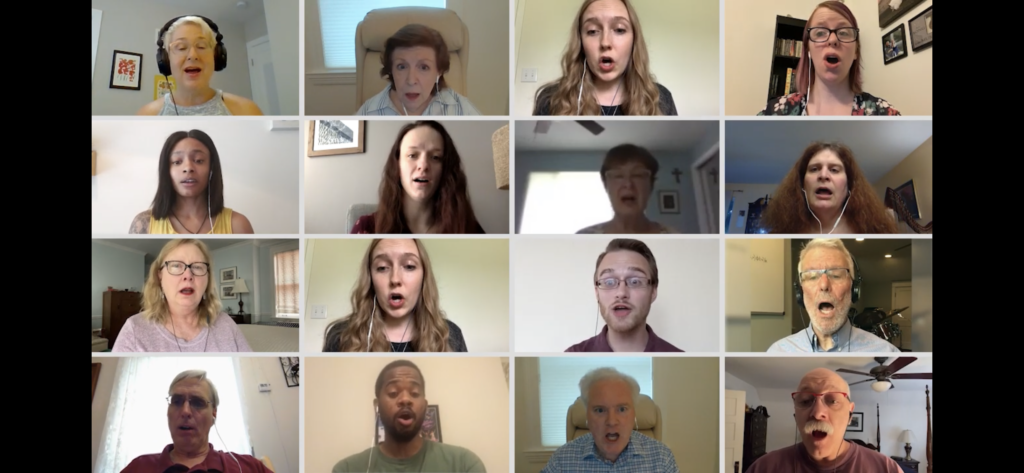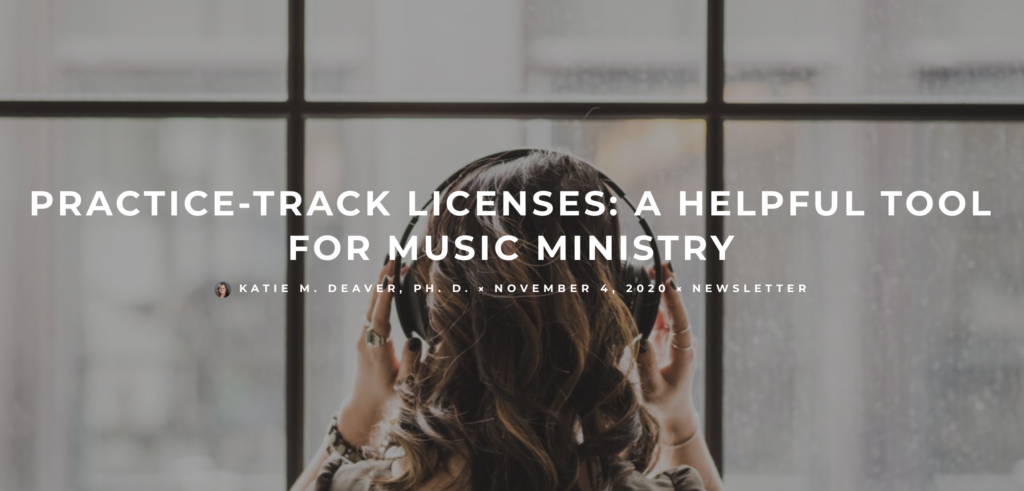With many congregations engaging in digital worship, virtual choirs are becoming more and more popular. They can be a great way to share musical worship while keeping social distance. But if you’ve tried singing “Happy Birthday” over Zoom, you know that singing together through the internet is not exactly pleasant to the ear: The lag in internet connection speeds on live video can make singing together very hard.
Virtual choirs can be wonderful because they create the illusion of a group singing together over the internet. But you need to make sure you have the permissions in place before you even begin the process.
What is permitted under your ONE LICENSE Podcast / Streaming License?
- Remember that the Podcast / Streaming License with ONE LICENSE covers a stream of a virtual choir performance in the context of your worship services, when that work is from one of our many Member Publishers.
- All license options with ONE LICENSE are strictly for non-commercial use.
- The worship service element is of paramount importance to what the ONE LICENSE Podcast / Streaming License covers.
If you wish to produce a virtual choir to exist on its own, and not in the context of a worship service, you will need to contact the copyright holder of the piece directly for permission. We find most virtual choir performances can take some effort, and so choir directors want them to live on their own outside of a worship service. Publishers can help you with these permissions, and there are also services that can clear rights on behalf of multiple publishers, including VirtualChoirHQ.com.
What about permissions for the process of building your virtual choir video? After all, making the video involves recording and sharing recordings back and forth over the internet. Here, we encourage you to check with the copyright holders about their specific policies.
Here are some steps you can take to start your virtual choir journey.
1. Make sure you have a Podcast / Streaming License with ONE LICENSE
Please confirm that the work you wish to include in your worship service is from one of our many Member Publishers. ONE LICENSE offers two options:
- The Limited Podcast / Streaming License gives you permission to post your videos online within a worship service, but not to provide text or melody lines either on screen or in an additional resource. The Limited Podcast / Streaming License is specifically designed for organizations that do not post or display lyrics or melody lines nor provide worship aids for their congregation.
- The Annual Reprint + Podcast / Streaming License Bundle includes all of the rights of the Limited Podcast / Streaming License in addition to the right to display lyrics or melody lines of covered music, either on screen or in a separate worship aid or protected PDF download.

2. Consider adding a Practice-Track License from ONE LICENSE
The Practice-Track License enables music ministers to create practice CDs or MP3s for their choir or ensemble members for rehearsal purposes. This may include:
- Sending separate vocal parts to multiple sections (for example, let the altos and sopranos practice their harmonies by listening to the recording that you’ve created).
- Sending vocal parts to each section of the choir (for example, do the tenors have a particularly tough part beginning at measure 20? No problem, provide them with a recording so they can listen and practice that section on their own!).
- Sending the accompaniment track so musicians can practice singing the piece and send it back to you for feedback.
- Share masters from participating Member Publishers to help your choir or instrumentalists learn the song.
For the virtual choir looking for a one-time special event opportunity, oftentimes Annual Licenses can be less expensive than a Single-Use or Event License. Additionally, the Annual License allows the video to be posted for as long as the license is active, rather than 24 hours with our Single-Use License or one week with our Event License. If you want to keep your video posted and archived on Facebook, YouTube, your church website, etc., an Annual License term is required.
3. Investigate audio and video editing software, or contract a local video editor
While there are both paid and free software programs, it’s important to consider both the audio and video individually. “Being a musician first, I prioritize how it sounds over how it looks, so I edit and mix audio first. It also helps me break up the project and enables me to start work as files are submitted,” shared Ace Gangoso, Director of Music and Ministry in Evanston, Illinois, and subscriber with ONE LICENSE. “I edit the videos together (with their original audio detached) and drop in my final audio mix. I find that slight discrepancies in timing between singers are less detectable visually than aurally.”
If you do not have the time or resources to edit videos on your own, you can also investigate local video editing services. Consult your colleagues for recommendations. Keep in mind that editors are professionals, and quotes for their services can range in price depending on the difficulty of editing required, region / territory, and number of recordings. These projects take time, so plan for that as well. Video editing could range from a day-long project on your own to planned-in-advance contracting with a professional. Be sure to discuss budget and timeline before making any firm commitments.
4. Search your repertoire and report your usage
Look through the pieces you would like to use, make note of the publisher, and be sure those titles are approved for Podcast / Streaming License permissions (or Practice-Track License permissions) from the applicable Member Publishers’ catalogs in our song database. Most, but not all, of our Member Publishers participate in this additional license type. Once that is confirmed, you will want to search the title of the piece in our music database and report your usage. Remember that our service does not cover reprinting or reproducing music engravings for choral use, so be sure to contact the copyright holder or Member Publisher for access to choral octavos, instrumental parts, or even if you wish to create your own custom arrangement of the song.
5. Prepare your choir
In your initial presentation to the choir about this video project, anticipate what the stumbling blocks are, and then address those issues. Some choir members will be reluctant or nervous, or feel like they don’t have “the right” technology. Assure your singers that the practice tracks will assist them. Provide clear written instructions of the equipment they will need and the steps for preparing and uploading the recording.
The rehearsal schedule can be quite tricky in light of the pandemic. Consider creating a schedule where members upload an initial recording of their part or meet with you one on one via Zoom. “Consider attaching certain vocal or musical goals with each recording (rhythm, cutoffs, phrasing, interpretation, breathing, tricky intervals, etc.),” Ace continued. “Pick repertoire that is both appropriate and allows opportunities to work on these goals.” Additional ideas include:
- Encourage your choir members to sing out and not feel restrained. It’s the editor’s job to mix and balance the recording, so encourage them to sing confidently.
- Give specific instructions on where to breathe, like you would in a normal rehearsal. This will ensure that the choir is as in sync as possible while being separated from each other.
- Encourage your choir members to smile and have fun with the process!
6. Make sure your choir members have the needed equipment
Once you feel like your choir members are prepared, make sure they have access to the following equipment:
- A device to listen to the recording they will be singing along with.
- Headphones or earbuds that are compatible with their listening device.
- A separate device to record the video.
Remind your choir members that they will need to listen to the music on one device and record themselves on another (they cannot listen and record simultaneously on the same device) and that headphones are a must to reduce the background noise.
7. Have choir members make their recordings
Instruct your choir members to (a) set up their recording device and start recording (b) start playing the rehearsal track on their listening device (with headphones connected), and (c) sing their part. Once they are done recording, have them upload the video file to an online file sharing service (Dropbox, Google Drive, etc.). These files are quite large, so emailing them will most likely not be an option. Be sure to provide instructions to your choir members on this process.
8. Complete the editing process
Once the files have been collected, you can begin the editing process. It is best to wait until you have all the files, or you will be editing and re-editing every video each time you add one more. Make sure to include copyright and licensing info, as you would for any of your videos.
Remember that the editing process takes time. Be mindful of previously determined timelines. Remember that while you are permitted to use commercial tracks (under your Practice-Track License) for rehearsal tracks for your choir members to make their recordings, those commercial tracks cannot appear or be heard in the final video that you upload to the internet.
9. Share your virtual choir with your church community
Your Podcast / Streaming License allows you to post your virtual choir video in the context of worship services, via social media, and / or web-hosting sites, for as long as your license is in effect.

Used with permission.
While all of the work that goes into making a virtual choir video for your worship services may feel a bit daunting, remember that this process serves as a great way for you to safely connect with your singers and your congregation during these challenging times. You might also consider doing more pieces with smaller ensembles so there are fewer vocal parts to spend time editing together.
These pieces can be such a gift to your church community, and in the context of worship, they can be a great way for everyone to stay connected. Again, contact the copyright owner if you want the video to stand on its own. If you have that permission, don’t forget to share your video with your congregation through your newsletter, on your Facebook page, and on your YouTube channel!
The ONE LICENSE team would like to thank Ace Gangoso for his contributions to this post.
Photo copyright: Tommy Lopez. This image is available for download at www.pexels.com.

